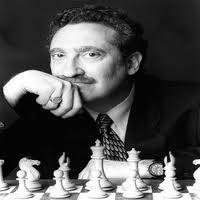
Pandolfini's Puzzler #26 - The King Takes a Walk
Professor: Good afternoon, class.
---
Lucian and Zephyr: Good afternoon, Professor.
---
Professor: I hope you’ve both been having a good day so far. It’s so nice and sunny out that I’ve been walking around enjoying the warmth.
---
Lucian: But Professor, it’s zero degrees outside.
---
Professor: Oh, is it?
---
Zephyr: How about the piles of snow and slippery ice? Didn’t you see any of that?

---
Professor: Not that much, to tell you the truth. I was so immersed in thought that I didn’t see much of anything other than what was going on in my mind.
---
Zephyr: Professor, isn’t that the way many newcomers approach chess?
---
Lucian: Yeah, Zephyr’s right. It’s kind of like thinking just about your own moves and plans and not thinking at all about what your opponent is going to do in turn.
---
Professor: Excellent points – the both of you! And that brings us to this afternoon’s session. It’s about a king walk – a king walk from the start of a chess game.
---
Lucian: But Professor, the king can’t walk anywhere at the start of a chess game.
---
Zephyr: At least not until a pawn is moved, or pieces get out of the way, or get taken out of the way somehow.
---
Professor: Let me set the stage properly. Pretend White plays these first four moves: 1. f3, 2. Kf2 3. Kg3, and Kh4.
---
---
Professor: Now the defender hasn’t been idle during this time. Black has just played his 4th move and mated White. Unfortunately, Black’s four moves are not shown in the diagram. Can you determine what they were?
---
Question 1: From the start of a game, if White plays as in diagram 1, how does Black have to play in order to mate on the 4th move?
---
Lucian: White’s moves are ridiculous, Professor. Who moves his king like that at the start of a game? A rank beginner?
---
Zephyr: Or maybe an absentminded chess player?
---
Professor: Or how about a teacher who simply wants to entertain you at the start of a lecture?
---
Zephyr: Okay, Professor, we get your point. But may I ask a question?
---
Professor: Of course. Go ahead.
---
Zephyr: Do Black’s first three moves have to make sense?
---
Professor: Well, they have to lead to the final position.

---
Lucian: Yes, but are they moves that a member of this class would be likely to play?
---
Professor: No, not necessarily a member of this class, especially not for Black’s third move. So, what do you think? Can you work together and tell me how to do it?
---
Zephyr: We shall try, Professor. We shall try.
---
Remarkably, after a bunch of failed tries, Zephyr and Lucian, combining their efforts, found a line, a bit absurd, that did work. Can you?
---
By the way, since the Professor was feeling exhilarated because of his morning stroll, and because of how nicely his students had solved the problem, he decided to give a bonus problem.
---
Professor: Suppose White starts a game by playing the same 3 moves as before, but on the 4th move plays 4. Kg4 (not 4. Kh4).
---
---
Question 2: From the start of a game, if White plays as in diagram 2, how does Black have to play in order to mate on the 4th move?
---
Answer below - Try to solve Professor Pando's puzzle first!
---
ANSWER #26
---
The solution to the first problem is 1. f3 e5 (Black could also play 1…e6) 2. Kf2 Qf6 3. Kg3 Qxf3+ 4. Kh4 Be7 mate!
---
---
The solution to the second problem is 1. f3 e5 (Black could also play 1…d6) 2. Kf2 h5 3. Kg3 h4+ 4. Kg4 d5 mate!
---
---
Take note
The above two problems can be described in various ways. Obviously, they are related in that one side plays the same three moves and then varies. They are also related by starting with the same position (the initial setup), and also by the length of the problem (four moves). Moreover, both sides in the two problems cooperate, even to the extent of playing absurd moves to fulfill stated tasks.
---
Additionally, both problems could be stated in words, without resorting to diagrams at all. To that end, they also could be described as “construction problems.” For example, for the second problem, the task could be phrased this way: “Construct a game that ends in four moves by discovered mate.” Accordingly, the solver doesn’t need a special diagram for the starting position.
RELATED STUDY MATERIAL
- Watch video number one of our ten-part (!) series on dicovered checks;
- This tactic happens on the tournament trail, as GM Benzoo shows;
- Now you're ready to solve a bunch of BoundingOwl's discovered attack puzzles!






